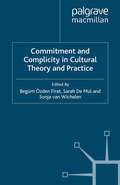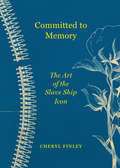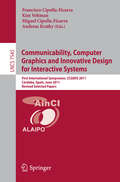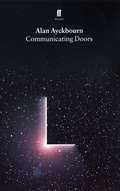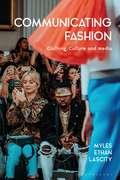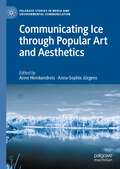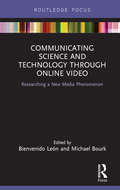- Table View
- List View
Commercial Visions: Science, Trade, and Visual Culture in the Dutch Golden Age
by Dániel MargócsyEntrepreneurial science is not new; business interests have strongly influenced science since the Scientific Revolution. In Commercial Visions, Dániel Margócsy illustrates that product marketing, patent litigation, and even ghostwriting pervaded natural history and medicine—the “big sciences” of the early modern era—and argues that the growth of global trade during the Dutch Golden Age gave rise to an entrepreneurial network of transnational science. Margócsy introduces a number of natural historians, physicians, and curiosi in Amsterdam, London, St. Petersburg, and Paris who, in their efforts to boost their trade, developed modern taxonomy, invented color printing and anatomical preparation techniques, and contributed to philosophical debates on topics ranging from human anatomy to Newtonian optics. These scientific practitioners, including Frederik Ruysch and Albertus Seba, were out to do business: they produced and sold exotic curiosities, anatomical prints, preserved specimens, and atlases of natural history to customers all around the world. Margócsy reveals how their entrepreneurial rivalries transformed the scholarly world of the Republic of Letters into a competitive marketplace. Margócsy’s highly readable and engaging book will be warmly welcomed by anyone interested in early modern science, global trade, art, and culture.
Commercial Visions: Science, Trade, and Visual Culture in the Dutch Golden Age
by Dániel MargócsyEntrepreneurial science is not new; business interests have strongly influenced science since the Scientific Revolution. In Commercial Visions, Dániel Margócsy illustrates that product marketing, patent litigation, and even ghostwriting pervaded natural history and medicine—the “big sciences” of the early modern era—and argues that the growth of global trade during the Dutch Golden Age gave rise to an entrepreneurial network of transnational science. Margócsy introduces a number of natural historians, physicians, and curiosi in Amsterdam, London, St. Petersburg, and Paris who, in their efforts to boost their trade, developed modern taxonomy, invented color printing and anatomical preparation techniques, and contributed to philosophical debates on topics ranging from human anatomy to Newtonian optics. These scientific practitioners, including Frederik Ruysch and Albertus Seba, were out to do business: they produced and sold exotic curiosities, anatomical prints, preserved specimens, and atlases of natural history to customers all around the world. Margócsy reveals how their entrepreneurial rivalries transformed the scholarly world of the Republic of Letters into a competitive marketplace. Margócsy’s highly readable and engaging book will be warmly welcomed by anyone interested in early modern science, global trade, art, and culture.
Commercial Visions: Science, Trade, and Visual Culture in the Dutch Golden Age
by Dániel MargócsyEntrepreneurial science is not new; business interests have strongly influenced science since the Scientific Revolution. In Commercial Visions, Dániel Margócsy illustrates that product marketing, patent litigation, and even ghostwriting pervaded natural history and medicine—the “big sciences” of the early modern era—and argues that the growth of global trade during the Dutch Golden Age gave rise to an entrepreneurial network of transnational science. Margócsy introduces a number of natural historians, physicians, and curiosi in Amsterdam, London, St. Petersburg, and Paris who, in their efforts to boost their trade, developed modern taxonomy, invented color printing and anatomical preparation techniques, and contributed to philosophical debates on topics ranging from human anatomy to Newtonian optics. These scientific practitioners, including Frederik Ruysch and Albertus Seba, were out to do business: they produced and sold exotic curiosities, anatomical prints, preserved specimens, and atlases of natural history to customers all around the world. Margócsy reveals how their entrepreneurial rivalries transformed the scholarly world of the Republic of Letters into a competitive marketplace. Margócsy’s highly readable and engaging book will be warmly welcomed by anyone interested in early modern science, global trade, art, and culture.
Commitment and Complicity in Cultural Theory and Practice
by Sarah De Mul Sonja Van Wichelen B. Firat S. De Mul S. Van WichelenAn international line-up of scholars examines the role of the intellectual in the twenty-first century, looking at the gap between contemporary cultural theory and cultural practice, and asking whether knowledge and methodologies in the humanities can intervene in everyday politics and vice-versa.
Committed To Memory: The Art Of The Slave Ship Icon (PDF)
by C. Stephen FinleyHow an eighteenth-century engraving of a slave ship became a cultural icon of black resistance, identity, and remembrance One of the most iconic images of slavery is a schematic wood engraving depicting the human cargo hold of a slave ship. First published by British abolitionists in 1788, it exposed this widespread commercial practice for what it really was--shocking, immoral, barbaric, unimaginable. Printed as handbills and broadsides, the image Cheryl Finley has termed the "slave ship icon" was easily reproduced, and by the end of the eighteenth century it was circulating by the tens of thousands around the Atlantic rim. Committed to Memory provides the first in-depth look at how this artifact of the fight against slavery became an enduring symbol of black resistance, identity, and remembrance. Finley traces how the slave ship icon became a powerful tool in the hands of British and American abolitionists, and how its radical potential was rediscovered in the twentieth century by black artists, activists, writers, filmmakers, and curators. Finley offers provocative new insights into the works of Amiri Baraka, Romare Bearden, Betye Saar, and many others. She demonstrates how the icon was transformed into poetry, literature, visual art, sculpture, performance, and film-and became a medium through which diasporic Africans have reasserted their common identity and memorialized their ancestors. Beautifully illustrated, Committed to Memory features works from around the world, taking readers from the United States and England to West Africa and the Caribbean. It shows how contemporary black artists and their allies have used this iconic eighteenth-century engraving to reflect on the trauma of slavery and come to terms with its legacy.
Common Core in the Content Areas: Balancing Content and Literacy
by Jessica BennettThe Common Core is requiring literacy across the curriculum, but what does that mean for teachers of subjects like math, science, and social studies who have a lot of content to cover? In this essential book, author Jessica Bennett reassures you that you don’t have to abandon all of your great content lessons and start from scratch. Instead, you can reflect on what you‘re already doing well and make adjustments and enhancements as necessary. Bennett starts with a clear breakdown of the Common Core ELA Social Studies/History and Science and Technical Subjects Standards for Grades 7-12 and what they actually look like. She provides a variety of practical strategies and scaffolds that you can use immediately to enhance your curriculum and meet the standards. You will learn how to... Incorporate a wider variey of texts into your currciulum Teach students to use each text with purpose, whether it is for close reading, support, argumentation, or research Assign meaningful group work and projects without feeling that they have to take up your whole curriculum Help students navigate their textbooks more effectively and read for information Use the Common Core to meet the needs of diverse learners Implement the four As strategy in which students absorb content, analyze information, argue reasons, and apply knowledge Use writing tasks to strengthen student comprehension of content Teach various forms of writing and the importance of text citations And more! Throughout the book, you’ll find tools such as unit planning sheets, daily lesson plan sheets, classroom handouts, sentence starters, and more. If you teach a content area, this must-have resource will help you meet the Common Core with ease!
Common Core in the Content Areas: Balancing Content and Literacy
by Jessica BennettThe Common Core is requiring literacy across the curriculum, but what does that mean for teachers of subjects like math, science, and social studies who have a lot of content to cover? In this essential book, author Jessica Bennett reassures you that you don’t have to abandon all of your great content lessons and start from scratch. Instead, you can reflect on what you‘re already doing well and make adjustments and enhancements as necessary. Bennett starts with a clear breakdown of the Common Core ELA Social Studies/History and Science and Technical Subjects Standards for Grades 7-12 and what they actually look like. She provides a variety of practical strategies and scaffolds that you can use immediately to enhance your curriculum and meet the standards. You will learn how to... Incorporate a wider variey of texts into your currciulum Teach students to use each text with purpose, whether it is for close reading, support, argumentation, or research Assign meaningful group work and projects without feeling that they have to take up your whole curriculum Help students navigate their textbooks more effectively and read for information Use the Common Core to meet the needs of diverse learners Implement the four As strategy in which students absorb content, analyze information, argue reasons, and apply knowledge Use writing tasks to strengthen student comprehension of content Teach various forms of writing and the importance of text citations And more! Throughout the book, you’ll find tools such as unit planning sheets, daily lesson plan sheets, classroom handouts, sentence starters, and more. If you teach a content area, this must-have resource will help you meet the Common Core with ease!
Common Core Reading Lessons: Pairing Literary and Nonfiction Texts to Promote Deeper Understanding
by Stacey O'Reilly Angie StooksburyThe Common Core is placing a heavier emphasis on nonfiction, but that doesn't mean you have to give up your literature lessons! In this book, English teachers Stacey O'Reilly and Angie Stooksbury describe how you can combine nonfiction with fiction to meet the standards and give students a deeper understanding of what they are reading. This practical book provides a variety of nonfiction reading strategies as well as ready-to-implement lesson plans and text pairing suggestions. You will get… A variety of useful strategies to help students analyze nonfiction Sample units with step-by-step agendas and lesson plans Ready-to-use classroom handouts and rubrics for assessment Suggested text pairings across genres and time periods
Common Core Reading Lessons: Pairing Literary and Nonfiction Texts to Promote Deeper Understanding
by Stacey O'Reilly Angie StooksburyThe Common Core is placing a heavier emphasis on nonfiction, but that doesn't mean you have to give up your literature lessons! In this book, English teachers Stacey O'Reilly and Angie Stooksbury describe how you can combine nonfiction with fiction to meet the standards and give students a deeper understanding of what they are reading. This practical book provides a variety of nonfiction reading strategies as well as ready-to-implement lesson plans and text pairing suggestions. You will get… A variety of useful strategies to help students analyze nonfiction Sample units with step-by-step agendas and lesson plans Ready-to-use classroom handouts and rubrics for assessment Suggested text pairings across genres and time periods
Common Image: Towards a Larger Than Human Communism (Image #201)
by Ingrid Hoelzl Rémi MarieWestern humanism has established a reifying and predatory relation to the world. While its collateral visual regime, the perspectival image, is still saturating our screens, this relation has reached a dead end. Rather than desperately turning towards transhumanism and geoengineering, we need to readjust our position within community Earth. Facing this predicament, Ingrid Hoelzl and Rémi Marie develop the notion of the common image - understood as a multisensory perception across species; and common ethics - a comportment that transcends species-bound ways of living. Highlighting the notion of the common as opposed to the immune, the authors ultimately advocate otherness as a common ground for a larger than human communism.
Common Prayer: The Language Of Public Devotion In Early Modern England
by Ramie TargoffCommon Prayer explores the relationship between prayer and poetry in the century following the Protestant Reformation. Ramie Targoff challenges the conventional and largely misleading distinctions between the ritualized world of Catholicism and the more individualistic focus of Protestantism. Early modern England, she demonstrates, was characterized less by the triumph of religious interiority than by efforts to shape public forms of devotion. This provocatively revisionist argument will have major implications for early modern studies. Through readings of William Shakespeare's Hamlet, Richard Hooker's Lawes of Ecclesiastical Politie, Philip Sidney's Apology for Poetry and his translations of the Psalms, John Donne's sermons and poems, and George Herbert's The Temple, Targoff uncovers the period's pervasive and often surprising interest in cultivating public and formalized models of worship. At the heart of this study lies an original and daring approach to understanding the origins of devotional poetry; Targoff shows how the projects of composing eloquent verse and improving liturgical worship come to be deeply intertwined. New literary practices, then, became a powerful means of forging common prayer, or controlling private and otherwise unmanageable expressions of faith.
Common spaces of urban emancipation (The A to Z Guide Series, No. 194)
by Stavros StavridesThis book explores contemporary urban experiences and how they are connected to practices of sharing and collaboration. There is a growing discussion on the cultural meaning and politics of urban commons, and Stavrides uses examples from Europe and Latin America to support the view that a world of mutual support and urban solidarity emerges today in, against and beyond existing societies of inequality. The concept of space commoning is discussed and considered in terms of its potential to promote emancipation. This is an exciting book, which explores the cultural meaning and politics of common spaces in conjunction with ideas connected with neighbourhood and community, justice and resistance, in order to trace elements of a different emancipating future.
Common spaces of urban emancipation
by Stavros StavridesThis book explores contemporary urban experiences and how they are connected to practices of sharing and collaboration. There is a growing discussion on the cultural meaning and politics of urban commons, and Stavrides uses examples from Europe and Latin America to support the view that a world of mutual support and urban solidarity emerges today in, against and beyond existing societies of inequality. The concept of space commoning is discussed and considered in terms of its potential to promote emancipation. This is an exciting book, which explores the cultural meaning and politics of common spaces in conjunction with ideas connected with neighbourhood and community, justice and resistance, in order to trace elements of a different emancipating future.
Communicability, Computer Graphics, and Innovative Design for Interactive Systems: First International Symposium, CCGIDIS 2011, Córdoba, Spain, June 28-29, 2011, Revised Selected Papers (Lecture Notes in Computer Science #7545)
by Francisco Cipolla Ficarra Kim Veltman Miguel Cipolla-Ficarra Andreas KratkyThis book constitutes the refereed proceedings of the First International Symposium on Communicability, Computer Graphics and Innovative Design for Interactive Systems, held in Córdoba, Spain, in June 2011. The 13 revised full papers presented were carefully reviewed and selected from various submissions. They examine latest breakthroughs and future trends within the communicability, computer graphics, and innovative design of interactive systems.
Communicating Creativity: The Discursive Facilitation of Creative Activity in Arts (Communicating in Professions and Organizations)
by Darryl HockingThis book provides an extensive and original analysis of the way that written and spoken communication facilitates creative practice in the university art and design studio. Challenging the established view of creativity as a personal attribute which can be objectively measured, the author demonstrates instead that creativity and creative practice are constructed through a complex array of intersecting discourses, each shaped by wider socio-historical contexts, beliefs and values. The author draws upon a range of methods and resources to capture this dynamic complexity from corpus linguistics to ethnography and multimodal analysis. This innovative volume will appeal to students and scholars of discourse analysis, creativity, and applied linguistics. It will also appeal to art and design educators.
Communicating Doors
by Alan AyckbournHow Ms Poopay Dayseer, a twenty-first century Specialist Sexual Consultant, whilst peddling her 'services' to an elderly hotel room client unexpectedly finds herself running for her life. How her flight through a communicating door brings her face to face with her own past and with Ruella who apparently died under suspicious circumstances twenty years earlier. And how Poopay's gradual friendship with that remarkable woman changes the future for both of them...A time-travelling comedy thriller, Communicating Doors was published to coincide with the West End opening in 1995.
Communicating Fashion: Clothing, Culture, and Media
by Myles Ethan LascityHow did you decide what to wear today? Did you base your selection on comfort or style? Did you want to blend in or stand out - or was it just the cleanest outfit available? We each make these decisions every day, reflecting how we view ourselves and impacting how others see us. Our choices matter - not just to us personally, but also to the magazine editors, brand ambassadors and trend forecasters who make a living by selling to us. Communicating Fashion introduces key concepts from the intersecting worlds of fashion and communication studies to connect how we all use clothing to express ourselves and how media systems support that process. In doing so, Myles Ethan Lascity explores social, cultural and ethical issues through the work of fashion journalism, brand promotions and the growing role of online influencers as well as the impact of film, television and art on self-image and expression.Key topics:- Advertising, Branding and Fashion Retail- Clothing, Art and Cultural Significance- Clothing as Group and Cultural Norms- Clothing, Identity and Interpersonal Communication- Fashion News and Tastemaking- Fashion, Social Media and Influencers- Meaning within the Fashion System- On-screen Clothing
Communicating Fashion: Clothing, Culture, and Media
by Myles Ethan LascityHow did you decide what to wear today? Did you base your selection on comfort or style? Did you want to blend in or stand out - or was it just the cleanest outfit available? We each make these decisions every day, reflecting how we view ourselves and impacting how others see us. Our choices matter - not just to us personally, but also to the magazine editors, brand ambassadors and trend forecasters who make a living by selling to us. Communicating Fashion introduces key concepts from the intersecting worlds of fashion and communication studies to connect how we all use clothing to express ourselves and how media systems support that process. In doing so, Myles Ethan Lascity explores social, cultural and ethical issues through the work of fashion journalism, brand promotions and the growing role of online influencers as well as the impact of film, television and art on self-image and expression.Key topics:- Advertising, Branding and Fashion Retail- Clothing, Art and Cultural Significance- Clothing as Group and Cultural Norms- Clothing, Identity and Interpersonal Communication- Fashion News and Tastemaking- Fashion, Social Media and Influencers- Meaning within the Fashion System- On-screen Clothing
Communicating Ice through Popular Art and Aesthetics (Palgrave Studies in Media and Environmental Communication)
by Anne Hemkendreis Anna-Sophie JürgensThis book brings together the perspectives of eminent and emerging scholars from fields as varied as science communication, art history, pop cultural studies, environmental studies, sciences studying ice and artists to explore the power of (popular) arts and aesthetics to communicate ice research and the urgency of environmental action. Examining the aesthetic strategies employed in images, (popular) visual fiction and narratives to convey meaning and awareness – and how they can be made fruitful for science communication – the project will generate new perspectives on how our collective environmental responsibility can be addressed and communicated across disciplines and divers audiences. In doing so, the volume will illuminate the cultural power of ice research and contribute to a better understanding of the cultural work that emerges from our ecological crisis.
Communicating The New: Methods to Shape and Accelerate Innovation
by Kim Erwin"Communicating radical innovation is very different from discussing marginal change. Erwin's book provides a serious analysis of why, in this era of VUCA—Volatility, Uncertainty, Complexity and Ambiguity—we need to change our individual and organizational modes of communication. Erwin then provides a series of concrete, practical communication methodologies that we so need. Communicating the New is a book that needs to be offered in all of our best business-school classes." —Bruce Nussbaum, author of Creative Intelligence, former assistant managing editor for BusinessWeek, and Professor of Innovation & Design at Parsons The New School of Design "One of the main problems with executing innovation in organizations is also one of the least obvious. Communicating The New reminds us about an often neglected but crucial part in the innovation process. Applying the principles contained in this book will increase your chances for innovation success, both inside your company—overcoming organizational barriers, as well as outside—convincing your customers. This is an essential read for those who not only preach for improving the current state of things, but more important to those responsible for executing it." —Luis Arnal, Managing Partner, INSITUM "I was hooked instantly. The names of people that I should give this book to keep building with each new chapter. Communicating the New is thorough as well as thoughtful in providing an impressive compendium of models, framework, methods, and tools for navigating the 21st-century challenges of creating The New. Finally, a useful resource to navigate the complexity of creating The New." —Clement Mok, Designer, Entrepreneur, and Instigator "Anyone who has experienced the challenge of co-creating The New and engaging enterprise audiences will find useful ways to produce insight, influence, and impact." —Paul Siebert, Director of Research + Strategy, Steelcase
Communicating The New: Methods to Shape and Accelerate Innovation
by Kim Erwin"Communicating radical innovation is very different from discussing marginal change. Erwin's book provides a serious analysis of why, in this era of VUCA—Volatility, Uncertainty, Complexity and Ambiguity—we need to change our individual and organizational modes of communication. Erwin then provides a series of concrete, practical communication methodologies that we so need. Communicating the New is a book that needs to be offered in all of our best business-school classes." —Bruce Nussbaum, author of Creative Intelligence, former assistant managing editor for BusinessWeek, and Professor of Innovation & Design at Parsons The New School of Design "One of the main problems with executing innovation in organizations is also one of the least obvious. Communicating The New reminds us about an often neglected but crucial part in the innovation process. Applying the principles contained in this book will increase your chances for innovation success, both inside your company—overcoming organizational barriers, as well as outside—convincing your customers. This is an essential read for those who not only preach for improving the current state of things, but more important to those responsible for executing it." —Luis Arnal, Managing Partner, INSITUM "I was hooked instantly. The names of people that I should give this book to keep building with each new chapter. Communicating the New is thorough as well as thoughtful in providing an impressive compendium of models, framework, methods, and tools for navigating the 21st-century challenges of creating The New. Finally, a useful resource to navigate the complexity of creating The New." —Clement Mok, Designer, Entrepreneur, and Instigator "Anyone who has experienced the challenge of co-creating The New and engaging enterprise audiences will find useful ways to produce insight, influence, and impact." —Paul Siebert, Director of Research + Strategy, Steelcase
Communicating Science and Technology Through Online Video: Researching a New Media Phenomenon (Routledge Focus on Communication Studies)
by Bienvenido León Michael BourkOnline video’s unique capacity to reach large audiences makes it a powerful tool to communicate science and technology to the general public. The outcome of the international research project "Videonline," this book provides a unique insight into the key elements of online science videos, such as narrative trends, production characteristics, and issues of scientific rigor. If offers various methodological approaches: a literature review, content analysis, and interviews and surveys of expert practitioners to provide information on how to maintain standards of rigour and technical quality in video production.
Communicating Science and Technology Through Online Video: Researching a New Media Phenomenon (Routledge Focus on Communication Studies)
by Bienvenido León Michael BourkOnline video’s unique capacity to reach large audiences makes it a powerful tool to communicate science and technology to the general public. The outcome of the international research project "Videonline," this book provides a unique insight into the key elements of online science videos, such as narrative trends, production characteristics, and issues of scientific rigor. If offers various methodological approaches: a literature review, content analysis, and interviews and surveys of expert practitioners to provide information on how to maintain standards of rigour and technical quality in video production.
Communicating with Virtual Worlds (Computer Animation Series)
by Nadia Magnenat Thalmann Daniel ThalmannThis volume presents the proceedings of COMPUTER GRAPHICS INTERNATIONAL '93 (COl '93), the Eleventh International Conference of the Computer Graphics Society (CGS), COl '93 has been held in Lausanne, Switzerland from June 21-25,1993 under the theme Communicating with Virtual Worlds. Since its foundation in 1983, COl conference has continued to attract high qUality research articles in all aspects of computer graphics and its applications. Previous conferences in this series were held in Japan (1983-1987), in Switzerland (1988), in the United Kingdom (1989), in Singapore (1990), in the United States (1991), and in Japan (1992). Future CG International conferences are planned in Australia (1994), and in the United Kingdom (1995). COS also organizes each year Computer Animation in Geneva, an international workshop and Computer Generated Film Festival. Two new CGS events are planned in 1993: Pacific Graphics '93 in Seoul and MMM '93, an International Conference on Multi-Media MOdeling in Singapore.
Communication Design: Insights from the Creative Industries
by Derek Yates Jessie PriceThe success of a piece of communication has always been dependent on the connection between content, form, audience and context – what the message is, who it's aimed at, what it looks like, and how and where it's communicated. In recent years the balance between these elements has shifted. This book bridges the gap between education and emerging practices to provide students and practitioners with the information they need to understand the new skillsets required to succeed in this changing communication environment. Organized into themes of brand, experience, conversation, participation, navigation, advocacy and critique, it explores the core ideas shaping contemporary practice. Alongside case studies of game changing projects, it uses analysis of historical context and interviews with key thinkers and practitioners to provide a relevant and contemporary guide to the creative employment landscape.

